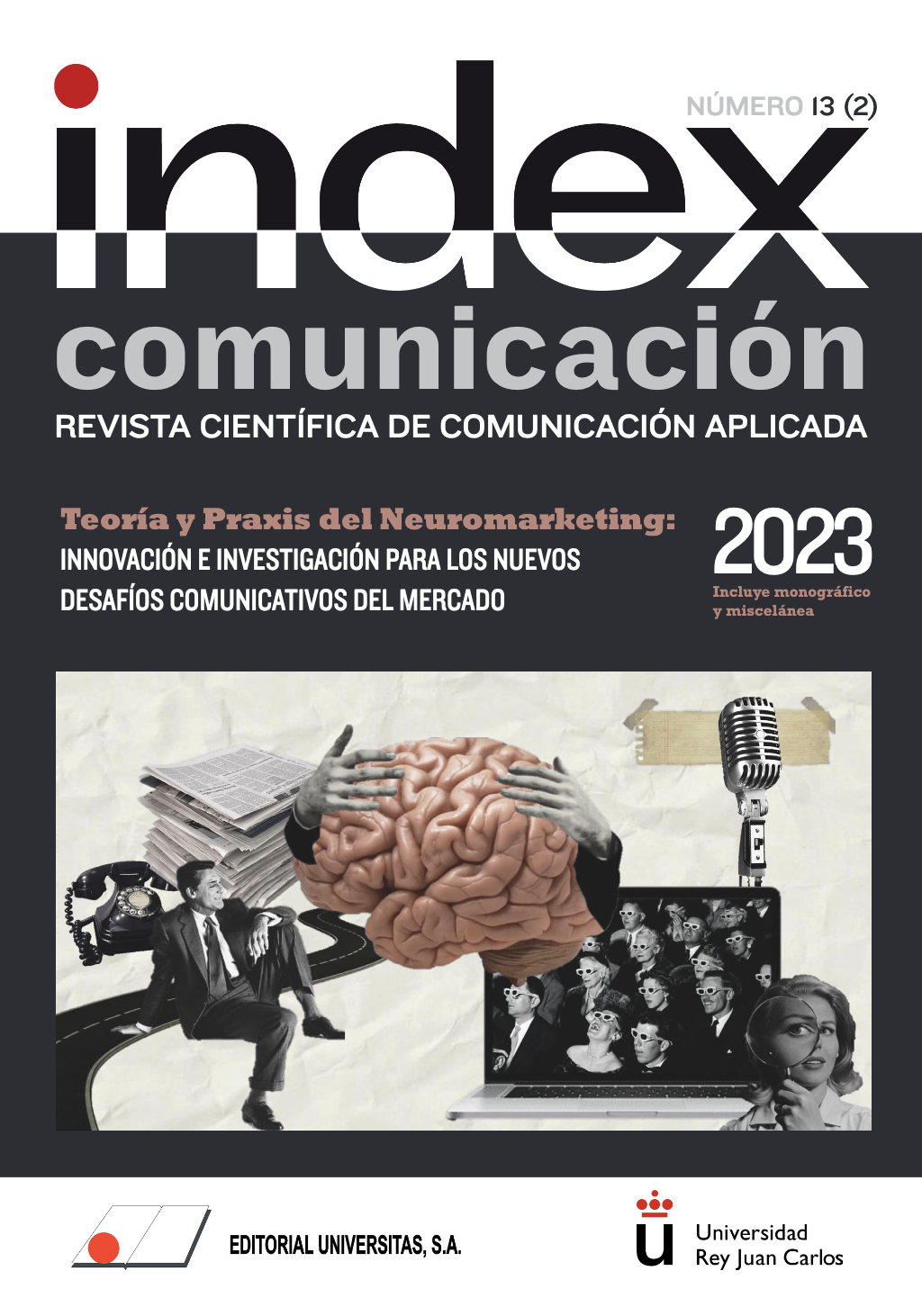A Review of the Use of PLS-SEM in Neuromarketing Research
Revisión del uso del PLS-SEM en las investigaciones sobre neuromarketing
DOI:
https://doi.org/10.33732/ixc/13/02ArevieKeywords:
Statistical Methods, Structural Equation Modelling, Neuromarketing, PLS-SEM, Neuromarketing Techniques, ReviewAbstract
The methodology applied for the statistical analysis for understanding, explaining and predicting consumer behavior represents an important issue for neuromarketing research. This research analyses the use of the PLS-SEM method in this area. A total of 20 articles, which employed at least one neuromarketing method and performed PLS-SEM analysis, were found in the main data bases (i.e., WOS, Scopus, and others). A lack of an adequate approach for sampling and treatment of small samples was generally found. Problems with the proper application of the common PLS-SEM analysis procedures for the assessment of the outer and inner models, as well as with the application of advanced PLS-SEM approaches. Future studies should assess the suitability of using a PLS-SEM approach, depending on the research objective supporting the method, the conditions supporting its use, and its limitations. Guidelines are provided to researchers on when PLS-SEM is an appropriate research tool for neuromarketing research, which analytical method to use, and how to validate and communicate the results.
Metrics
References
AHMADPOUR, M.; KORDNAEIJ, A.; YUNESI, A. & MOSHABBAKI, A. (2019). Effective advertisement design to attract customers’ attention: implementing sensory marketing’s principle for feature extraction. Journal of organizational behavior research, 4(S2), 1-34. https://tinyurl.com/2ua4mf6e
BADENES‐ROCHA, A.; BIGNE, E. & RUIZ, C. (2022). Impact of cause‐related marketing on consumer advocacy and cause participation: A causal model based on self‐reports and eye‐tracking measures. Psychology & Marketing, 39(1), 214-226. doi.org/10.1002/mar.21590
BARCLAY, D.; HIGGINS, C. & THOMPSON, R. (1995). The partial least squares (PLS) approach to casual modelling: Personal computer adoption and use as an illustration. Technology studies, 2(2), 285-309. https://tinyurl.com/3dh2b6a2
BECKER, J. M.; CHEAH, J. H.; GHOLAMZADE, R.; RINGLE, C. M. & SARSTEDT, M. (2023). PLS-SEM’s Most Wanted Guidance. International Journal of Contemporary Hospitality Management, 35(1), 321-346.
doi.org/10.1108/IJCHM-04-2022-0474
BELL, L.; VOGT, J.; WILLEMSE, C.; ROUTLEDGE, T.; BUTLER, L.T. y SAKAKI, M. (2018). Beyond Self-Report: A Review of Physiological and Neuroscientific Methods to Investigate Consumer Behavior. Frontiers in Psychology, 9, 1-16. doi.org/10.3389/fpsyg.2018.01655
BENÍTEZ, J.; HENSELER, J.; CASTILLO, A. & SCHUBERTH, F. (2020). How to perform and report an impactful analysis using partial least squares: Guidelines for confirmatory and explanatory IS research. Information & Management, 57(2), 103168. doi.org/10.1016/j.im.2019.05.003
BETTIGA, D. & LAMBERTI, L. (2020). Future-Oriented Happiness: Its Nature and Role in Consumer Decision-Making for New Products. Frontiers in Psychology, 11(929), 1-14. doi.org/10.3389/fpsyg.2020.00929
BETTIGA, D.; LAMBERTI, L. & NOCI, G. (2017). Do mind and body agree? Unconscious versus conscious arousal in product attitude formation. Journal of Business Research, 75, 108-117. doi.org/10.1016/j.jbusres.2017.02.008
BRAND, B. M. & REITH, R. (2022). Cultural differences in the perception of credible online reviews–The influence of presentation format. Decision Support Systems, 154(113710), 1-16. doi.org/10.1016/j.dss.2021.113710
BYRNE, A.; BONFIGLIO, E.; RIGBLY, C. & EDELSTYN, N. (2022). A systematic review of the prediction of consumer preference using EEG measures and machine-learning in neuromarketing research. Brain Informatics, 9(27), 1-23. doi.org/10.1186/s40708-022-00175-3
CASADO-ARANDA, L.-A. & SÁNCHEZ-FERNÁNDEZ, J. (2021). Advances in neuroscience and marketing: analyzing tool possibilities and research opportunities. Spanish Journal of Marketing - ESIC, 26(1), 3-22. doi.org/10.1108/SJME-10-2021-0196
CHERUBINO, P.; MARTÍNEZ, L. A. C.; CARATÙ, M.; CARTOCCI, G.; DI FLUMER; G., MODICA, M.; ROSSI, D.; MANCINI, M. & TRETTEL, A. (2019). Consumer Behavior through the Eyes of Neurophysiological Measures: State-of-the Art and Future Trends. Computational Intelligence and Neuroscience, ID 1976847. doi.org/10.1155/2019/1976847
CHIN, W. W. & DIBBERN, J. (2010). A Permutation Based Procedure for Multi-Group PLS Analysis: Results of Tests of Differences on Simulated Data and a Cross Cultural Analysis of the Sourcing of Information System Services between Germany and the USA. In V. Esposito Vinzi, W. W. Chin, J. Henseler, & H. Wang (Eds.), Handbook of Partial Least Squares: Concepts, Methods and Applications (Springer Handbooks of Computational Statistics Series, vol. II) (pp. 171-193). Springer.
COHEN, J. (1988). Statistical power analysis for the behavioral sciences (2nd ed.). Mahwah, NJ: Lawrence Erlbraum.
DANKS, N. P.; SHARMA, P. N. & SARSTEDT, M. (2020). Model selection uncertainty and multimodel inference in partial least squares structural equation modeling (PLS-SEM). Journal of Business Research, 113(March), 13-24. doi.org/10.1016/j.jbusres.2020.03.019
DIJKSTRA, T. K. & HENSELER, J. (2015). Consistent partial least squares path modelling. MIS Quarterly, 39(2), 297-316. https://www.jstor.org/stable/26628355
ERSÖZ, S. & SCHRÖDER, H. (2022). Convenience and Emotions through Facial Expressions: Evidence from Online Medication Shopping Behavior. The Retail and Marketing Review, 18(2), 94-121. https://tinyurl.com/2p8semck
FÉLIX, R. & BORGES, A. (2014). Celebrity endorser attractiveness, visual attention, and implications for ad attitudes and brand evaluations: A replication and extension. J Brand Manag, 21, 579-593. doi.org/10.1057/bm.2014.24
GARZÓN-PAREDES, A. R., & ROYO-VELA, M. (2021). Experimenting through neuromarketing to measure the impact of Spanish cultural heritage. In R.J. Howlett & L.C. Jain (Eds.), Advances in Tourism, Technology and Systems: Selected Papers from, ICOTTS20, Vol. 209 (pp. 380-400). Springer Singapore. doi.org/10.1007/978-981-33-4260-6_34
GARZÓN-PAREDES, A. R., & ROYO-VELA, M. (2023). Emotional and cognitive response to cultural heritage and effects on virtual image of destination; an experimental comparison of data with encephalograms and measurement scales. Vegueta. Anuario de la Facultad de Geografía e Historia, 23, 1, 160-180. https://tinyurl.com/534cbdpr
GARZÓN-PAREDES, A. R., & ROYO-VELA, M. (2023). Emotional and cognitive responses to cultural heritage: a neuromarketing experiment using virtual reality in the tourist destination image model context. Journal of Positive Psychology and Wellbeing, 27(2), 630-651.
GEFEN, D.; RIGDON, E. E. & STRAUB, D. (2011). Editor’s Comments: An Update and Extension to SEM Guidelines for Administrative and Social Science Research. MIS Quarterly, 35(2), 3-14. doi.org/10.2307/23044042
GONZÁLEZ-RODRÍGUEZ, M. R.; DÍAZ-FERNÁNDEZ, M. C. & GÓMEZ, C.P. (2020). Facial-expression recognition: An emergent approach to the measurement of tourist satisfaction through emotions. Telematics and Informatics, 51(101404), 1-14. doi.org/10.1016/j.tele.2020.101404
GRIGALIUNAITE, V. & PILELIENE, L. (2016). Emotional or rational? The determination of the influence of advertising appeal on advertising effectiveness. Scientific Annals of Economics and Business, 63(3), 391-414. https://tinyurl.com/y7wkfzbm
GUENTHER, P.; GUENTHER, M.; RINGLE, C. M.; ZAEFERIAN, G. & CARTWRIGHT, S. (2023). Improving PLS-SEM use for business marketing research. Industrial Marketing Management, 111, 127-142. doi.org/10.1016/j.indmarman.2023.03.010
HAIR, J. F.; HULT, G. T. M.; RINGLE, C. M. & SARSTEDT, M. (2022). A Primer on Partial Least Square Equation Modelling (PLS-SEM) (3rd ed). Thousand Oaks, CA: Sage.
HAIR, J. F.; RISHER, J. J.; SARSTEDT, M. & RINGLE, C. M. (2019). When to use and how to report the results of PLS-SEM. European Business Review, 31(1), 2-24. doi.org/10.1108/EBR-11-2018-0203
HAIR, J. F.; SARSTEDT, M.; RINGLE, C. M. & MENA, J. A. (2012). An assessment of the use of partial least square equation modelling in marketing research. J. of Acad. Mark. Sci, 40, 414-433. doi.org/10.1007/s11747-011-0261-6
HAIR, J. F.; SARSTEDT, M.; MATTHEWS, L. M. & RINGLE, C. M. (2016). Identifying and treating unobserved heterogeneity with FIMIX-PLS: part I – method. European Business Review, 28(1), 63-76.
doi.org/10.1108/EBR-09-2015-0094
HAIR, J. F.; SARSTEDT, M.; RINGLE, C. M. & GUDERGAN, S. P. (2017). Advanced Issues in Partial Least Squares Structural Equation Modeling. Thousand Oaks, CA: Sage.
HENSELER, J. (2021). Composite-based Structural Equation Modeling: Analyzing Latent and Emergent Variables. The Guilford Press.
HENSELER, J.; HUBONA, G. & RAY, P. A. (2016). Using PLS path modeling in new technology research: updated guidelines. Industrial Management & Data Systems, 116(1), 2-20. doi.org/10.1108/IMDS-09-2015-0382
HENSELER, J.; RINGLE, C. M. & SARSTEDT, M. (2015). A new criterion for assessing discriminant validity in variance-based structural equation modeling. Journal of the Academy of Marketing Science, 43, 115-135. doi.org/10.1007/s11747-014-0403-8
HENSELER, J.; RINGLE, C. M. & SARSTEDT, M. (2016). Testing measurement invariance of composites using partial least squares. International Marketing Review, 33(3), 405-431. doi.org/10.1108/IMR-09-2014-0304
HERRANDO, C.; JIMÉNEZ-MARTÍNEZ, J.; MARTÍN-DE HOYOS, M. J.; ASAKAWA, K. & YANA, K. (2022). Emotional responses in online social interactions: the mediating role of flow. Asia Pacific Journal of Marketing and Logistics, (ahead-of-print). doi.org/10.1108/APJML-02-2022-0091
KENNY, D. A. (2018). Moderation. davidakenny.net. https://davidakenny.net/cm/moderation.htm
KLESEL, M.; SCHUBERTH, F.; HENSELER, J. & NIEHAVES, B. (2019). A test for multigroup comparison using partial least squares path modeling. Internet Research, 29(3), 464-477. doi.org/10.1108/IntR-11-2017-0418
KLESEL, M.; SCHUBERTH, F.; NIEHAVES, B. & HENSELER, J. (2022). Multigroup Analysis in Information Systems Research using PLS-PM. ACM SIGMIS Database: The DATABASE for Advances in Information Systems, 53(3), 26-48. doi.org/10.1145/3551783.3551787
KOCK, N. (2018). Single missing data imputation in PSL-based structural equation modeling. Journal of Modern Applied Statistics Methods, 17(1), 1-23. doi.org/10.22237/jmasm/1525133160
LI, S. (2019). Emotional Appeals in Tourism TV Commercials: A Psycho-Physiological Study. Journal of Hospitality & Tourism Research, 43(6), 783-806. doi.org/10.1177/1096348019828440
LI, S.; WALTERS, G.; PACKER, J. & SCOTT, N. (2017). A Comparative Analysis of Self-Report and Psychophysiological Measures of Emotion in the Context of Tourism Advertising. Journal of Travel Research, 57(8), 1078-1092. doi.org/10.1177/0047287517733555
LIENGAARD, B. D.; SHARMA, P. N.; HULT, G. T. M.; JENSEN, M. B.; SARSTEDT, M.; HAIR, J. F. & RINGLE, C.M. (2021). Prediction: Coveted, yet forsaken? Introducing a cross-validated predictive ability test in partial least squares path modelling. Decision Sciences, 52(2), 362-392. doi.org/10.1111/deci.12445
MARCOULIDES, G. A.; CHIN, W. W. & SAUNDERS, C. (2009). A Critical Look at Partial Least Squares Modeling. MIS Quarterly, 33(1), 171-175. doi.org/10.2307/20650283
MONTEIRO, P.; GUERREIRO, J. & LOUREIRO, S. M. C. (2020). Understanding the role of visual attention on wines’ purchase intention: an eye-tracking study. International Journal of Wine Business Research, 32(2), 161-179. doi.org/10.1108/IJWBR-03-2019-0017
NITZL, C.; ROLDÁN, J. L. & CEPEDA, G. (2016). Mediation analysis in partial least squares path modelling. Helping researchers discuss more sophisticated models. Industrial Management and Data Systems, 116(9), 1849-1864. doi.org/10.1108/IMDS-07-2015-0302
QU, Q.-X.; GUO, F. & DUFFY, V. G. (2017). Effective use of human physiological metrics to evaluate website usability: An empirical investigation from China. Aslib Journal of Information Management, 69(4), 370-388. doi.org/10.1108/AJIM-09-2016-0155
RAWNAQUE, F. S.; RAHMAN, K. M.; AHNWAR, S. F.; VAIDYANATHN, R.; CHAU, T.; SARKER, F. & AL MAMUN, K. (2020).Tehnological advancements and opportunities in Neuromarketing: a systematic review. Brain Informatics, 7(10), 1-19. doi.org/10.1186/s40708-020-00109-x
RIGDON, E. E.; SARSTEDT, M. & RINGLE, C. M. (2017). On Comparing Results from CB-SEM and PLS-SEM: Five Perspectives and Five Recommendations. Marketing ZFP, 39(3), 4-16. doi.org/10.15358/0344-1369-2017-3-4
RINGLE, C. M.; SARSTEDT, M.; SINKOVICS, N. & SINKOVICS, R. R. (2023). A Perspective on Using Partial Least Squares Structural Equation Modelling in Data Articles. Data in Brief, 48(June), 109074. doi.org/https://doi.org/10.1016/j.dib.2023.109074
ROYO-VELA, M. & GARZÓN-PAREDES, A. (2023). Effects of heritage on destination image: multi-method research based on an appraisal approach to emotional response in-situ. Journal of Heritage Tourism, 1-25. doi.org/10.1080/1743873X.2023.2178926
SARSTEDT, M.; HAIR, J. F. & RINGLE, C. M. (2022). “PLS-SEM: Indeed a Silver Bullet” – Retrospective Observations and Recent Advances. Journal of Marketing Theory & Practice. doi.org/10.1080/10696679.2022.2056488
SARSTEDT, M.; HAIR, J. F.; CHEAH, J. H.; BECKER, J. M. & RINGLE, C. M. (2019). How to Specify, Estimate, and Validate Higher-order Constructs in PLS-SEM. Australasian Marketing Journal, 27(3), 197-211. https://doi.org/10.1016/j.ausmj.2019.05.003
SARSTEDT, M.; HAIR, J. F.; PICK, M.; LIENGAARD, B. D.; RADOMIR, L. & RINGLE, C. M. (2022). Progress in Partial Least Squares Structural Equation Modeling Use in Marketing Research in the Last Decade. Psychology & Marketing, 39(5), 1035-1064. doi.org/10.1002/mar.21640
SARSTEDT, M.; RINGLE, C. M. & HAIR, J. F. (2021). Partial Least Square Equation Modelling. In Homburg, C., Klarmann, M., & Vomberg, A. (Eds.), Handbook of Marketing Research (pp. 1-47). Springer, Cham.
doi.org/10.1007/978-3-319-05542-8_15-2
SCHMUELI, G.; SARSTEDT, M.; HAIR, J. F.; CHEAH, J. H.; TING, H. & RINGLE, C. M. (2019). Predictive model assessment in PLS-SEM: Guidelines for using PLSpredict. European Journal of Marketing, 53(11), 2322-2347. doi.org/10.1108/EJM-02-2019-0189
SCHUBERTH, F.; RADEMAKER, M. E. & HENSELER, J. (2022). Assessing the overall fit of composite model estimated by partial least squares equation modelling. European Journal of Marketing. doi.org/10.1108/EJM-08-2020-0586 (forthcoming)
SHARMA, PRATYUSH N.; LIENGAARD, B. D.; HAIR, J. F.; SARSTEDT, M. & RINGLE, C. M. (2022). Predictive model assessment and selection in composite-based modeling using PLS-SEM: extensions and guidelines for using CVPAT. European Journal of Marketing. doi.org/10.1108/EJM-08-2020-0636
SHARMA, PRATYUSH NIDHI; SHMUELI, G.; SARSTEDT, M.; DANKS, N. & RAY, S. (2021). Prediction‐Oriented Model Selection in Partial Least Squares Path Modeling. Decision Sciences, 52(3), 567-607. doi.org/10.1111/deci.12329
SHMUELI, G.; RAY, S.; VELASQUEZ ESTRADA, J. M. & CHATLA, S. B. (2016). The elephant in the room: Predictive performance of PLS models. Journal of Business Research, 69(10), 4552-4564. doi.org/10.1016/j.jbusres.2016.03.049
STREUKENS, S. & LEROI-WERELDS, S. (2016). Bootstrapping and PLS-SEM: A step-by-step guide to get more out of your bootstrap results. European Management Journal, 34(6), 618-632. doi.org/10.1016/j.emj.2016.06.003
UHM, J. P.; LEE, H. W.; HAN, J. W. & KIM, D. K. (2022). Effect of background music and hierarchy-of-effects in watching women's running shoes advertisements. International Journal of Sports Marketing and Sponsorship, 23(1), 41-58. doi.org/10.1108/IJSMS-09-2020-0159
WANG, H.; LU, S. & LIU, Y. (2022). Missing data imputation in PLS-SEM. Quality & Quantity, 56(January), 4777-4795.
doi.org/10.1007/s11135-022-01338-4
YEN, C. & CHIANG, M. C. (2020). Trust me, if you can: a study on the factors that influence consumers’ purchase intention triggered by chatbots based on brain image evidence and self-reported assessments. Behaviour & Information Technology, 40(11), 1177-1194. doi.org/10.1080/0144929X.2020.1743362
Downloads
Published
How to Cite
Issue
Section
License
Copyright (c) 2023 Vasilica-Maria Margalina, Álvaro Jiménez Sánchez, Janna Susanne Ehrlich (Autor/a)

This work is licensed under a Creative Commons Attribution-NonCommercial 4.0 International License.
Authors who submit to this journal agree to the following terms:
Authors retain copyright and ensure the magazine's right to be the first publication of the work as licensed under a Creative Commons Attribution-NoComercial 4.0 International License that allows others to share the work with an acknowledgment of authorship of the work and the initial publication in this magazine, with no commercial purpose.
Authors can establish separate additional agreements for non-exclusive distribution of the version of the work published in the magazine (for example, to an institutional repository or publish it in a book), with an acknowledgment of its initial publication in this journal.
It allows and authors are encouraged to disseminate their work electronically (eg, in institutional repositories or on their own website) prior to and during the submission process, as it can lead to productive exchanges, as well as a citation more early and most of the published work (See The Effect of Open Access).















